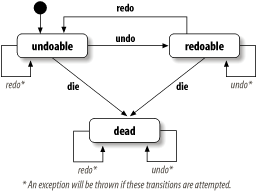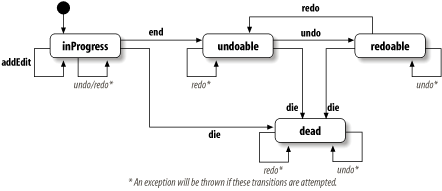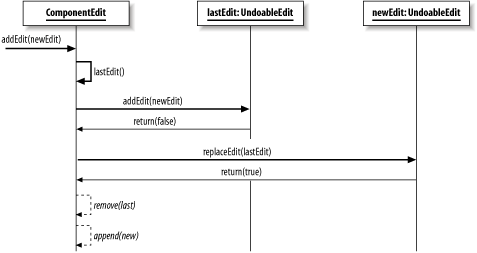18.1 The Swing Undo Facility
| The javax.swing.undo package contains two interfaces and seven classes (two of which are exception classes). These, along with a listener interface and event class from the javax.swing.event package, comprise the undo facility shown in Figure 18-1. Figure 18-1. The Swing undo facility Here is a brief overview of each class:
Now that we have a basic understanding of what we have to work with, let's look at the details of each of these interfaces and classes. 18.1.1 The UndoableEdit InterfaceThe UndoableEdit interface defines a set of operations that can be performed on any object that needs to provide undo and redo functionality. Typically, classes that implement this interface are fairly small. Instances of these classes represent single, undoable changes ("edits") made to the state of the application or some component of the application. UndoableEdits can be thought of as being in one of three states, as shown in the state diagram in Figure 18-2. Since UndoableEdit is just an interface, it can't really enforce this state model. However, this is the intended state model, and the AbstractUndoableEdit class described in the next section does enforce it. Alternate implementations of this interface should not deviate from this model. Figure 18-2. UndoableEdit state chart When initially created, the edit represents some change that has just been done and is now undoable.[1] Once the edit is undone, it becomes redoable. Having been undone, it may be redone, causing it to become undoable again. This sequence can be repeated indefinitely. If, for whatever reason, an edit can no longer be used, it can be "killed," taking it to the dead state. Once killed, the edit can no longer be undone or redone. Dead is dead.
18.1.1.1 PropertiesTable 18-1 shows the properties defined by UndoableEdit.
UndoableEdits are typically displayed to a user, allowing the user to decide to undo or redo some action that was performed. In support of this, UndoableEdit provides three properties that name an edit: presentationName , undoPresentationName, and redoPresentationName. These properties might have values such as delete, undo delete, and redo delete, respectively. The last two names are typically just variations on the first. The significant property may be used to distinguish edits of different levels of importance. An insignificant edit, for example, might not be displayed to the user, instead being performed as a side effect of some other edit. To understand the idea of an insignificant edit, think of a computer chess game. The process of making a move might consist of clicking on a piece, causing the square the piece is sitting on to change color, then clicking on the destination square, completing the move. You might implement the game's undo capability by having an edit responsible for changing the color of the square of the selected piece and another edit representing the move itself. The first edit is not the type of edit you'd want to display to the user. Instead, you'd track this as an insignificant edit. 18.1.1.2 Edit-merging methodsUndoableEdit provides two methods for merging the changes described by two edits into a single edit. Implementations of these methods are under no obligation to support this merging feature. Such implementations simply return false, indicating that no merging of the edits was done. The addEdit( ) and replaceEdit( ) methods are similar. addEdit( ) asks the edit it is invoked upon to absorb an input edit, and replaceEdit( ) asks the edit if it would like to replace the input edit. The idea is that addEdit( ) is called on an existing edit, passing in a new one, while replaceEdit( ) is called on a new edit, passing in an existing one. Absorbing edits can be useful in a variety of scenarios. One use of this feature might be to group together a series of "delete-character" edits created as a user holds down the Delete or Backspace key. By merging these into a single edit, the user would be able to undo the series of deletions with a single undo operation, rather than having to undo each individual character. For another example, consider our chess game again. If a user clicked on three different pieces before deciding which one to move, each subsequent piece selection edit would probably want to replace the previous one so that the temporary selections don't become part of the undoable history.
For more information on these methods, see the discussion of CompoundEdit. 18.1.1.3 Other methods
18.1.2 The AbstractUndoableEdit ClassThis implementation of UndoableEdit provides useful default behavior for the methods defined in the interface. It enforces the state model described in the previous section using two internal boolean properties, alive and done. A new AbstractUndoableEdit is both alive and done. A call to die( ) makes it no longer alive. A call to undo( ) makes it no longer done, while redo( ) makes it done again. In order for an edit to be undone, it must be both alive and done. To be redone, it must be alive but not done. Subclasses of AbstractUndoableEdit should take advantage of this fundamental state support by calling super.undo( ) and super.redo( ) in the first line of their undo( ) and redo( ) methods, respectively. This frees the subclass from having to worry about enforcing the edit's state model. 18.1.2.1 PropertiesTable 18-2 shows the default values AbstractUndoableEdit specifies for the properties defined in UndoableEdit.
The presentationName property is empty by default. RedoPresentationName and undoPresentationName are formed by appending presentationName to RedoName and UndoName (protected constants, see below), respectively. By default, all AbstractUndoableEdits are significant. There is no way to change the values of these properties once the object is created. Concrete edit classes need to provide some way (possibly just returning a constant value from the property accessor) to define the presentation name. 18.1.2.2 ConstantsTable 18-3 shows the two protected constants that AbstractUndoableEdit defines. These constants are used by default when forming the redoPresentationName and undoPresentationName properties. In the 1.2.x and 1.3.0 releases, their values were hardcoded English strings. Starting with 1.3.1, these values are retrieved using the UIManager.getString( ) method with the keys "AbstractUndoableEdit.redoText" and "AbstractUndoableEdit.undoText", respectively.
18.1.2.3 Constructor
18.1.2.4 UndoableEdit methodsThe following methods provide a simple default implementation of the UndoableEdit interface:
18.1.2.5 Creating a toggle editIn this example, we'll create a simple extension of AbstractUndoableEdit called UndoableToggleEdit .[2]
This edit provides the ability to undo clicking on a JToggleButton (or one of its subclasses, JRadioButton or JCheckBox). A program using this new edit creates a new UndoableToggleEdit each time the toggle button is clicked. If undo( ) is called on the edit, it changes the state of the button back to its previous state. A redo( ) call sets the button back to the state it was in when it was passed into the UndoableToggleEdit constructor. Here's the source code for this new edit class: // UndoableToggleEdit.java // import javax.swing.*; import javax.swing.undo.*; // An UndoableEdit used to undo the clicking of a JToggleButton public class UndoableToggleEdit extends AbstractUndoableEdit { private JToggleButton button; private boolean selected; // Create a new edit for a JToggleButton that has just been toggled. public UndoableToggleEdit(JToggleButton button) { this.button = button; selected = button.isSelected( ); } // Return a reasonable name for this edit. public String getPresentationName( ) { return "Toggle " + button.getText( ) + " " + (selected ? "on" : "off"); } // Redo by setting the button state as it was initially. public void redo( ) throws CannotRedoException { super.redo( ); button.setSelected(selected); } // Undo by setting the button state to the opposite value. public void undo( ) throws CannotUndoException { super.undo( ); button.setSelected(!selected); } } We inherit most of our behavior from AbstractUndoableEdit. The most important thing to learn from this class is that the edit keeps track of enough information to undo or redo an operation. In our case, this is done by holding a reference to the toggle button the edit applies to, as well as by keeping a boolean to hold the value of the toggle. For more complex undo capabilities, your edit classes probably need more information than this. Another important thing to notice is that both undo( ) and redo( ) call their super implementations to ensure that the edit is in the appropriate state. Next, let's look at a small application that shows how we might use this new edit class. In this (admittedly worthless) application, we create three toggle buttons that we place in the center of a frame. Below these toggle buttons, we add two JButtons one for undo and one for redo. Each time one of the toggle buttons is pressed (see the actionPerformed( ) method in the SimpleListener inner class), we create a new UndoableToggleEdit (discarding any previous edit). At this time, we also update the labels on our undo and redo buttons using the names defined by the new edit. If the undo button is clicked, we call undo( ) on the edit, which changes the state of the last toggle button we clicked. Clicking the redo button switches it back again by calling redo( ) on the edit. When we initially create the edit or when we perform an undo or redo (note the finally blocks in the two anonymous listener classes), we enable or disable the undo and redo buttons based on the edit's response to canUndo( ) and canRedo( ). For now, we can only undo the most recent edit. Later in the chapter, we'll present a similar example that supports multiple undo operations. Here's the source code for this sample application: // UndoableToggleApp.java // import javax.swing.*; import javax.swing.event.*; import javax.swing.undo.*; import java.awt.*; import java.awt.event.*; // A sample app showing the use of UndoableToggleEdit public class UndoableToggleApp extends JFrame { private UndoableEdit edit; private JButton undoButton; private JButton redoButton; // Create the main frame and everything in it. public UndoableToggleApp( ) { // Create some toggle buttons (and subclasses). JToggleButton tog = new JToggleButton("ToggleButton"); JCheckBox cb = new JCheckBox("CheckBox"); JRadioButton radio = new JRadioButton("RadioButton"); // Add our listener to each toggle button. SimpleListener sl = new SimpleListener( ); tog.addActionListener(sl); cb.addActionListener(sl); radio.addActionListener(sl); // Lay out the buttons. Box buttonBox = new Box(BoxLayout.Y_AXIS); buttonBox.add(tog); buttonBox.add(cb); buttonBox.add(radio); // Create undo and redo buttons (initially disabled). undoButton = new JButton("Undo"); redoButton = new JButton("Redo"); undoButton.setEnabled(false); redoButton.setEnabled(false); // Add a listener to the undo button. It attempts to call undo( ) on the // current edit, then enables/disables the undo/redo buttons as appropriate. undoButton.addActionListener(new ActionListener( ) { public void actionPerformed(ActionEvent ev) { try { edit.undo( ); } catch (CannotUndoException ex) { ex.printStackTrace( ); } finally { undoButton.setEnabled(edit.canUndo( )); redoButton.setEnabled(edit.canRedo( )); } } }); // Add a redo listener, which is just like the undo listener, // but for redo this time. redoButton.addActionListener(new ActionListener( ) { public void actionPerformed(ActionEvent ev) { try { edit.redo( ); } catch (CannotRedoException ex) { ex.printStackTrace( ); } finally { undoButton.setEnabled(edit.canUndo( )); redoButton.setEnabled(edit.canRedo( )); } } }); // Lay out the undo/redo buttons. Box undoRedoBox = new Box(BoxLayout.X_AXIS); undoRedoBox.add(Box.createGlue( )); undoRedoBox.add(undoButton); undoRedoBox.add(Box.createHorizontalStrut(2)); undoRedoBox.add(redoButton); undoRedoBox.add(Box.createGlue( )); // Lay out the main frame Container content = getContentPane( ); content.setLayout(new BorderLayout( )); content.add(buttonBox, BorderLayout.CENTER); content.add(undoRedoBox, BorderLayout.SOUTH); setSize(400, 150); } public class SimpleListener implements ActionListener { // When a toggle button is clicked, we create a new UndoableToggleEdit (which // replaces any previous edit). We then get the edit's undo/redo names and set // the undo/redo button labels. Finally, we enable/disable these buttons by // asking the edit what we are allowed to do. public void actionPerformed(ActionEvent ev) { JToggleButton tb = (JToggleButton)ev.getSource( ); edit = new UndoableToggleEdit(tb); undoButton.setText(edit.getUndoPresentationName( )); redoButton.setText(edit.getRedoPresentationName( )); undoButton.getParent( ).validate( ); undoButton.setEnabled(edit.canUndo( )); redoButton.setEnabled(edit.canRedo( )); } } // Main program just creates the frame and displays it public static void main(String[] args) { JFrame f = new UndoableToggleApp( ); f.setDefaultCloseOperation(JFrame.EXIT_ON_CLOSE); f.setVisible(true); } } Figure 18-3 shows what this application looks like after we've played with it for a while. We just got through toggling the radio button and then clicking on the undo button. Figure 18-3. Sample UndoableToggleApp display 18.1.3 The CompoundEdit ClassCompoundEdit is a subclass of AbstractUndoableEdit that supports the aggregation of multiple edits into a single composite edit. After a CompoundEdit is created, UndoableEdits can be added by calling addEdit( ). Once all edits have been added, a new method, end( ), must be called on the CompoundEdit to indicate that the creation of the edit is complete (after this point, addEdit( ) just returns false). Only after end( ) has been called can the edit be undone. CompoundEdit implements undo( ) and redo( ) by calling the appropriate method on each of the edits added to it, allowing all of them to be executed at once. Figure 18-4 shows a state chart very similar to the one we saw for UndoableEdit. The key difference is that a CompoundEdit is initially inProgress and does not allow either undo( ) or redo( ). The end( ) method must be called after adding the edits to the CompoundEdit to enable undo. Figure 18-4. CompoundEdit state chart 18.1.3.1 PropertiesCompoundEdit defines the properties shown in Table 18-4. inProgress is the only new property here. It indicates whether edits may be added to the CompoundEdit. Initially true, this property is set to false when end( ) is called. It never changes back to true after that.
The values of presentationName , redoPresentationName, and undoPresentationName are initially the same as the values defined in AbstractUndoableEdit. However, once edits are added, these values are set to the values of the corresponding properties of the last edit added. The significant property is initially false. Once edits are added, this value is determined by checking the significance of the child edits. If any of them are set to true, the CompoundEdit is considered to be significant. 18.1.3.2 Protected field
18.1.3.3 Constructor
18.1.3.4 UndoableEdit methodsThe following methods override the implementations of the UndoableEdit methods defined in AbstractUndoableEdit:
18.1.3.5 Other methods
18.1.4 Using Compound EditsThe following example is a modification of the UndoableToggleApp from the previous section. This version uses CompoundEdit to allow multiple button toggles to be undone at once. Each time one of the toggle buttons is clicked, a new UndoableToggleEdit is created and added to a CompoundEdit. Once you've toggled as many buttons as you want, you can click the end button, which causes end( ) to be called on the CompoundEdit and enables the undo button. Clicking on this button causes undo( ) to be called on the CompoundEdit, which in turn calls undo( ) on each of the UndoableToggleEdits that were added to it. Clicking on one of the toggle buttons again causes the CompoundEdit to be replaced with a new one, to which new edits will be added until the end button is pressed again. Here's the source code for this example. Much of it is unchanged from the UndoableToggleApp example, so we've highlighted the significant changes. // UndoableToggleApp2.java // import javax.swing.*; import javax.swing.event.*; import javax.swing.undo.*; import java.awt.*; import java.awt.event.*; // A sample app showing the use of UndoableToggleEdit and CompoundEdit public class UndoableToggleApp2 extends JFrame { private CompoundEdit edit; private JButton undoButton; private JButton redoButton; private JButton endButton; // Create the main frame and everything in it. public UndoableToggleApp2( ) { // Create some toggle buttons (and subclasses). JToggleButton tog = new JToggleButton("ToggleButton"); JCheckBox cb = new JCheckBox("CompoundEdit ExampleCheckBox"); JRadioButton radio = new JRadioButton("RadioButton"); // Add our listener to each toggle button. SimpleListener sl = new SimpleListener( ); tog.addActionListener(sl); cb.addActionListener(sl); radio.addActionListener(sl); // Lay out the buttons. Box buttonBox = new Box(BoxLayout.Y_AXIS); buttonBox.add(tog); buttonBox.add(cb); buttonBox.add(radio); // Create undo and redo buttons (initially disabled). undoButton = new JButton("Undo"); redoButton = new JButton("Redo"); endButton = new JButton("End"); undoButton.setEnabled(false); redoButton.setEnabled(false); endButton.setEnabled(false); // Add a listener to the undo button. It attempts to call undo( ) on the // current edit, then enables/disables the undo/redo buttons as appropriate. undoButton.addActionListener(new ActionListener( ) { public void actionPerformed(ActionEvent ev) { try { edit.undo( ); } catch (CannotUndoException ex) { ex.printStackTrace( ); } finally { undoButton.setEnabled(edit.canUndo( )); redoButton.setEnabled(edit.canRedo( )); } } }); // Add a redo listener, which is just like the undo listener, but for redo this // time. redoButton.addActionListener(new ActionListener( ) { public void actionPerformed(ActionEvent ev) { try { edit.redo( ); } catch (CannotRedoException ex) { ex.printStackTrace( ); } finally { undoButton.setEnabled(edit.canUndo( )); redoButton.setEnabled(edit.canRedo( )); } } }); // Add an end listener. This listener will call end( ) on the CompoundEdit and // update the undo/redo buttons. endButton.addActionListener(new ActionListener( ) { public void actionPerformed(ActionEvent ev) { edit.end( ); endButton.setEnabled(false); undoButton.setEnabled(edit.canUndo( )); redoButton.setEnabled(edit.canRedo( )); } }); // Lay out the undo/redo/end buttons. Box undoRedoEndBox = new Box(BoxLayout.X_AXIS); undoRedoEndBox.add(Box.createGlue( )); undoRedoEndBox.add(undoButton); undoRedoEndBox.add(Box.createHorizontalStrut(2)); undoRedoEndBox.add(redoButton); undoRedoEndBox.add(Box.createHorizontalStrut(2)); undoRedoEndBox.add(endButton); undoRedoEndBox.add(Box.createGlue( )); // Lay out the main frame. Container content = getContentPane( ); content.setLayout(new BorderLayout( )); content.add(buttonBox, BorderLayout.CENTER); content.add(undoRedoEndBox, BorderLayout.SOUTH); setSize(400, 150); } public class SimpleListener implements ActionListener { public void actionPerformed(ActionEvent ev) { if (edit == null || edit.isInProgress( ) == false) edit = new CompoundEdit( ); JToggleButton tb = (JToggleButton)ev.getSource( ); UndoableEdit togEdit = new UndoableToggleEdit(tb); edit.addEdit(togEdit); endButton.setEnabled(true); undoButton.setEnabled(edit.canUndo( )); redoButton.setEnabled(edit.canRedo( )); } } // Main program just creates the frame and displays it. public static void main(String[] args) { JFrame f = new UndoableToggleApp2( ); f.setDefaultCloseOperation(JFrame.EXIT_ON_CLOSE); f.setVisible(true); } } 18.1.5 The UndoableEditEvent ClassUndoableEditEvent is an event class (it extends java.util.EventObject) defined in the javax.swing.event package. It is used by components that support undo to notify interested listeners (implementing UndoableEditListener) that an UndoableEdit has been performed. A little later in the chapter, we'll see an example that uses the UndoableEditEvent class and the UndoableEditListener interface. 18.1.5.1 PropertyUndoableEditEvent defines the property shown in Table 18-5. The edit property contains the UndoableEdit that was generated, causing this event to be fired.
18.1.5.2 Constructor
18.1.6 The UndoableEditListener InterfaceClasses that generate UndoableEditEvents fire these events to UndoableEditListeners. This is a simple interface (like UndoableEditEvent, it can be found in the javax.swing.event package), defining a single method:
|
EAN: 2147483647
Pages: 289

